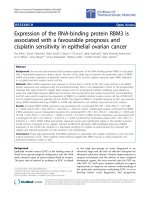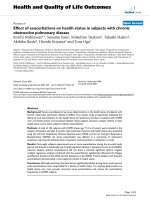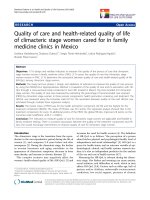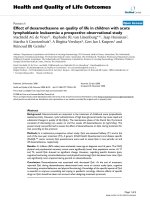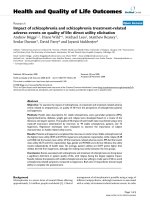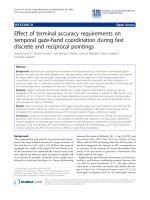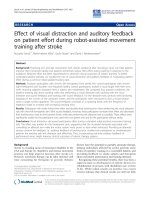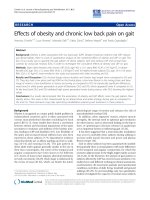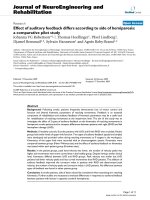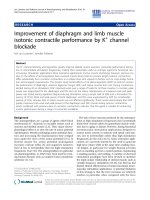báo cáo hóa học: "Effect of obesity and low back pain on spinal mobility: a cross sectional study in women" pptx
Bạn đang xem bản rút gọn của tài liệu. Xem và tải ngay bản đầy đủ của tài liệu tại đây (1.23 MB, 8 trang )
RESEARC H Open Access
Effect of obesity and low back pain on spinal
mobility: a cross sectional study in women
Luca Vismara
1*
, Francesco Menegoni
1,2
, Fabio Zaina
3
, Manuela Galli
2
, Stefano Negrini
3
, Paolo Capodaglio
2
Abstract
Background: obesity is nowadays a pandemic condition. Obese subjects are commonly characterized by
musculoskeletal disorders and particularly by non-specific chronic low back pain (cLBP). However, the relationship
between obesity and cLBP remains to date unsupported by an objective measurement of the mechanical
behaviour of the spine and its morphology in obese subjects. Such analysis may provide a deeper understanding
of the relationships between function and the onset of clinical symptoms.
Purpose: to objectively assess the posture and function of the spine during standing, flexion and lateral bending
in obese subjects with and without cLBP and to investigate the role of obesity in cLBP.
Study design: Cross-sectional study
Patient sample: thirteen obese subjects, thirteen obese subjects with cLBP, and eleven healthy subjects were
enrolled in this study.
Outcome measures: we evaluated the outcome in terms of angles at the initial standing position (START) and at
maximum forward flexion (MAX). The range of motion (ROM) between START and MAX was also computed.
Methods: we studied forward flexion and lateral bending of the spine using an optoelectronic system and pa ssive
retroreflective markers applied on the trunk. A biomechanical model was developed in order to analyse kinematics
and define angles of clinical interest.
Results: obesity was characterized by a generally reduced ROM of the spine, due to a reduced mobility at both
pelvic and thoracic level; a static postural adaptation with an increased anterior pelvic tilt. Obesity with cLBP is
associated with an increased lumbar lordosis.
In lateral bending, obesity with cLBP is associated with a reduced ROM of the lumbar and thoracic spine, whereas
obesity on its own appears to affect only the thoracic curve.
Conclusions: obese individuals with cLBP showed higher degree of spinal impairment when compared to those
without cLBP. The observed obesity-related thoracic stiffness may characterize this sub-group of patients, even if
prospective studies should be carried out to verify this hypothesis.
Introduction
Obesity is recognised as a major public health problem
in industrialized countries and it is associated with var-
ious musculoskeletal disorders, including impair ment of
the spine [1-3] and osteoarthritis [4,5]. The prevalence
of osteoarthritis in obese patients is reported to be 34%
(17% at knee, 7% at spine level and 10% other districts) ,
with a significant correlation between body mass index
(BMI) and functional joints impairment [6]. The
repo rted prevalence of low back pain (LBP) was 22% on
5724 obese adults 60 years or old er, with a linear corre-
lation between LBP and BMI [7].
While body weight is only a weak risk factor for LBP
[7], whether obesity is correlated with LBP is still under
debate: the association is generally stronger in large
population studies than in smaller or occupatio nal stu-
dies [7-11]. The BM I-pain association is consistent with
what has been observed a mong persons with obesity
seeking weight loss [12,13] and in papers suggesting that
weight reduction can reduce reports of musculoskeletal
* Correspondence:
1
Orthopaedic Rehabilitation Unit and Clinical Lab for Gait Analysis and
Posture, Ospedale San Giuseppe, Istituto Auxologico Italiano, IRCCS, Via
Cadorna 90, I-28824, Piancavallo (VB), Italy
Vismara et al. Journal of NeuroEngineering and Rehabilitation 2010, 7:3
/>JNER
JOURNAL OF NEUROENGINEERING
AND REHABILITATION
© 2010 Vismara et a l; licensee BioMed Central Ltd. This is an Open Access article distributed under the terms of the Cre ative Commons
Attribution License (http://creati vecommons.org/licenses/by/2.0), which permits unre stricted use, distribution, and reproduction in
any medium, provided the original work is properly cited.
pain [14,15]. Being persistently overweight was asso-
ciated with disk degeneration at Ma gnetic Resonance
Imaging [16].
When differences in spine biomechanics are investi-
gated, only a moderate link between LBP and BMI
appears [3,17-23]. During stance, obese patients show an
hyperextension of the lumbar spine [24,25] similar to
the anterior translation of the center of mass described
by Whitcome in pregnant women [26]. Quantitative evi-
dence exists that excess of weight negatively affects
common daily movements, such as standing up [27,28],
walking [29-33], lateral bending [34], and forward flex-
ion [35]. Few studies demonst rate a correlation between
obesity and functional impairment of the spine second-
ary to weakness and stiffness of the lumbar muscles,
possibly leading to LBP and disability [19,36-38]; more-
over, there is a lack of quantitative data on spinal mobi-
lity in obese subjects who already suffer from LBP [19].
Theaimofourstudywastoproposeaquantitative
protocol to describe and quantify the functional mobility
of th e spine during flexion and lateral b ending in order
to investigate the relationship between obesity and LBP.
Materials and methods
Thirty seven adult female volunteers were recruited and
divided in three group: 13 obese patients without LBP
(Group O) (age: 38.3 ± 8.9 years, BMI: 39.2 ± 3.6 kg/
m
2
), 13 obese patients with non-specific c hronic LBP
[39,40 ] (Group cLBP) (age: 42.8 ± 11.9 years, BMI: 41.9
±5.3kg/m
2
), and 11 healthy women with no history of
musculoskeletal complaints as the control group (Group
C)(age:31.9±8.6years,BMI:20.1±1.2kg/m
2
). We
considered three groups of female subjects to take into
account the same gynoid mass distribution and because
the prevalence of cLBP is greater in women than in
men [ 41]. At the time of the study, cLBP patients were
not under any treatment. cLBP patients were defined
according to clinical examination and duration of pain
[40-42], and all of them performed an X-ray to exclude
secondary cLBP. The study has been approved by t he
local Ethical Committee and all the participants gave
written informed consent.
Experimental setup
The study was conducted at the Laboratory of Gait and
Posture Analysis of our Institute. Data were ac quired
with a 6-camera optoelectronicmotionanalysissystem
(Vicon 460, Vicon Motion Systems, Oxford, UK) operat-
ing at a sampling rate of 100 Hz. The re flective markers
were spherical with diameter of 14 mm.
The location of the markers, the movements, the
angles, and the considered parameters have been pre-
viously described [43]. Five markers were placed by the
same expert operator along the spine (Figure 1): two on
the thoracic (T1 and T6), two on the lumbar vertebrae
(L1 and L3), and one on the sacrum (S1). Four markers
were positioned on the pelvis: left/right anterior (lASIS/
rASIS) and left/right posterior superior iliac spines
(lPSIS/rPSIS). Two markers were then applied on the
acromion of the left (lSHO) and right shoulder (rSHO).
We analyzed two different tasks: forward flexion and
lateral bending both sides. Subjects were instructed to
perform the test comfortably at their own preferred
speed with feet apart at shoulder width. Each movement
was repeated three times and the best acquisition was
chosen for further analysis.
Modelling and data processing
Three-dimensional data from the opto electronic system
were processed using the multi-purpose biomechanical
software SMART Analyzer (BTS, Milan, Italy). As for
forward flexion, we identified the ang les sh own in figure
2 to characterize trunk mobility in the sagittal plane, as
described in our previous study [43]. We considered:
forward trunk inclination (aFTI), anterior pelvic tilt
( a1), angle related to lordosis (aL) lumbar movement
(a2), angle related to kyphosis (aK), and thoracic move-
ment (a3).
Figure 1 Marker setup. Markers were placed on superior posterior
iliac spines (LPSI, RPSI), on superior anterior iliac spines (LASI, RASI
not visible), on spine spinous processes (S1, L3, L1, T6, T1) and on
acromions (LACR, RACR).
Vismara et al. Journal of NeuroEngineering and Rehabilitation 2010, 7:3
/>Page 2 of 8
The above mentioned angles were evaluated at the
initial standing position (START) and at maximum for-
ward flexion (MAX). The range of motion (ROM)
between START and MAX was also computed. As for
lateral bending, similar angles were considered ( Figure
3): lateral trunk inclination (bLTI), pelvic obliquity (b1),
lumbar curve (bDC), lumbar movement (b2), thoracic
curve (bPC), thoracic movement (b3), and shoulders
(b4).
Again the ROM for each angle was evaluated, by com-
puting the difference between maximum left and right
bending. We also computed the symmetry index of lat-
eral trunk inclination (bLTI), representing the difference
between the maximum left- and right-bend, and the
centre of rotation (CoR), a semi-quantitative index used
to locate the centre of ro tation based on the trajectories
ofthemarkersinthefrontalplaneduringthelateral
bending. In particular, we identified the CoR by defining
different zones delimited by the markers (Figure 4).
Statistical Analysis
TheStatisticasoftware(Statistica6.0,StatSoft,Tulsa,
OK) was used for all the analyses. The Shapiro-Wilk’s
W test was first used to veri fy the normal data distribu-
tion, and then parametric (one-way ANOVA followed
by post-hoc analysis LSD t est) or non-parametric (Krus-
kall-Wallis ANOVA followed by Mann-Whitney U-test
with Bonferroni correction) tests were adopted.
Results
The analyzed groups were not homogeneous in terms of
age (ANOVA, p < 0.0001) and BMI (ANOVA, p <
0.0001): specifically, post hoc analysis reported that
there were no differences between cLBP and O in terms
of age and BMI (p = NS). C was statistically different
from the other groups in terms of BMI (post hoc LSD,
Figure 2 Representation of markers and angles in sagittal
plane during forward flexion. On the left (Figure 2A) are shown:
frontal trunk inclination (aFTI), pelvic obliquity (a1), angle related to
kyphosis (aK), angle related to lordosis (aL). On the right (Figure 2B)
are represented: lumbar movement (a2), and thoracic movement
(a3).
Figure 3 Representa tion of markers and angles in frontal plane during lateral bending. On the left (Figure 3A) are shown: lateral trunk
inclination (bLTI), pelvic obliquity (b1), proximal curvature (PC), distal curvature (bDC). On the right (Figure 3B) are represented: lumbar
movement (b2), thoracic movement (b3), and angle of shoulders (b4).
Vismara et al. Journal of NeuroEngineering and Rehabilitation 2010, 7:3
/>Page 3 of 8
p < 0.0001). Age was significantly different between C
and cLBP (post hoc LSD, p = 0.01).
Forward Flexion
When compared to C, flexion ROM was reduced in O and
cLBP. In the obese subjects, this reduction was mainly
influenced by the differences observed during standing
posture when compared to C, while for cLBP it was the
combination of the reduction in maximum flexion and the
standing posture simil ar to the obese subjects. The angle
related to lordosis was significantly increased in cLBP in
the start position as compared to C and O. Similar beha-
viour was observ ed in MAX but no statistical diffe rences
in ROM were evident. The angle related to kyphosis was
similar in the three groups in START, but ROM was sig-
nificantly reduced in O and cLBP.
An increased anterior pelvic tilt angle was present in O
and LBP, while no statistically significant reduction in
ROM was observed. Lumbar movement in cLBP was sig-
nificantly reduced in MAX when compared to O as well
as to C. In START, statistically significant difference was
found only between cLBP and C. The thoracic movement
was significant ly reduced in O and cLBP as compared to
C, not only in MAX but also in ROM (Table 1).
Lateral bending
cLBP showed a significant reduction in lateral bending
and a reduced lumbar ROM as compared to O and C.
No differences among groups were observed in lumbar
movement and in pelvic obliquity.
The thoracic curve was statistically different among the
three groups, with cLBP yielding the worst results. cLBP
also showed a significant reduction in thoracic and
shoulder movements as compared to O and C (Table 2).
The qualitative analysis of lateral bending by locating
the CoR showed different trajectories among groups:
subjects i n C showed an “hourglass” shape (Figure 5A),
while O and cLBP showed a “ cone” shape (Figure 5B
and Figure 5C). CoR was located between L1 and L3 in
C (CoR Zone: 2) and between S1 and ASIS in O and
cLBP (CoR Zone: 5; Mann-Whitney p = 0.007 and p =
0.012 respectively).
Discussion
No dif ferences between cLBP and O has be en found in
terms of age and BMI (p = NS) while, as expected, C
was statistically different from other groups i n terms of
BMI. Age was the only unexpected significant difference
between C and cLBP. An age difference may well play a
role in obese patients and account for the results
obtained by compariso ns with controls. H owever, all the
groups were in working age, which is usual in LBP stu-
dies, which in turn consider the whole range of working
ages.
Our analysis has revealed biomechanical differences in
spinal mobility between C and O under static and
dynamicconditions.Thedifferencesaremorepro-
nounced when comparing obese patients with to those
without LBP. Prospective studies are needed to prove a
cause-effect relationship, but still the gradient of differ-
ences observed in the three groups seems to support the
hypothesis that obesity modifies spinal posture and
function favouring the onset of cLBP. Postural analysis
shows significant differences at lumbar and pelvic level
among g roups. Obesity seems to induce an increase in
anterior pelvic tilt while maintaining a normal lumbar
lordosis under static conditions. Spinal p osture and
Figure 4 Lateral bending movement in frontal plane, with representation of markers (sphere: stand ing position, square: left bending,
pentagon: right bending), and the localization of the center of rotation (CoR). On the right the code assigned to the CoR to characterize
the movement. The represented normal subject was classified as Zone 1, because CoR was located between T6 and L1).
Vismara et al. Journal of NeuroEngineering and Rehabilitation 2010, 7:3
/>Page 4 of 8
Table 1 Main results about the forward flexion movement.
C O cLBP
Mean (SD) Mean (SD) Mean (SD) ANOVA
Sagittal Plane
Forward trunk inclination
(aFTI) [deg]
START (*) 1.2 (2.7) 5.0 (2.5) 4.0 (3.5) § p = 0.0093
MAX (**) 119.4 (9.2) 112.1 (7.5) 103.9 (14.8) p = 0.0056
ROM (*,**) 118.2 (9.3) 107.1 (7.5) 99.8 (14.6) § p = 0.0041
Anterior pelvic tilt (a1) [deg] START (*,**) 11.2 (2.4) 20.9 (7.8) 23.9 (8.6) p = 0.0003
MAX 72.7 (6.5) 75.2 (13.7) 77.1 (12.4) NS
ROM 61.4 (6.2) 54.3 (10.4) 53.2 (9.5) NS
Angle related to lordosis
(aL) [deg]
START (**,***) 30.2 (5.2) 32.7 (8.6) 41.0 (12.9) p = 0.023
MAX (*,**,***) -21.3 (2.6) -14.6 (5.1) -5.5 (8.5) § p = 0.0001
ROM 51.5 (5.0) 47.3 (5.9) 46.5 (15.9) NS
Lumbar movement (a2)
[deg]
START (**) -1.7 (5.1) -7.8 (13.5) -15.3 (14.2) § p = 0.022
MAX (**,***) 22.8 (5.2) 19.2 (11.0) 10.9 (11.3) p = 0.01
ROM 24.5 (5.6) 27.0 (12.2) 26.1 (12.2) NS
Angle related to kyphosis
(aK) [deg]
START 23.7 (6.4) 25.5 (4.1) 24.9 (5.9) NS
MAX (*) 34.6 (8.2) 27.2 (5.5) 29.0 (7.4) p = 0.048
ROM (*,**) 10.9 (7.2) 1.8 (5.4) 4.1 (6.4) p = 0.004
Thoracic movement (a3)
[deg]
START -10.2 (6.7) -9.0 (14.6) -4.9 (9.6) NS
MAX (*,**) 33.9 (5.2) 25.5 (6.6) 23.4 (9.2) p = 0.003
ROM (*,**) 44.1 (8.5) 34.5 (10.0) 28.2 (9.6) p = 0.001
Trunk, pelvis, lumbar and thoracic values were used in case of forward flexion of the considered segment, negative values otherwise. Negative values of the
angle related to lordosis were used to highlight a kyphosis curve of the lordosis segment.
§ Kruskall-Wallis ANOVA,
* differences between C and O (p < 0.05)
** differences between C and LBP (p < 0.05)
*** differences between O and LBP (p < 0.05).
Table 2 Main results about the lateral bending movement.
C O cLBP
Frontal Plane Mean (SD) Mean (SD) Mean (SD) ANOVA
Lateral trunk inclination
(bLTI) [deg]
START -0.2 (1.0) 0.7 (1.5) 0.5 (1.7) § NS
ROM (**,***) 77.8 (13.7) 80.7 (8.0) 60.7 (21.3) p = 0.005
Pelvic obliquity (b1) [deg] START -0.5 (1.7) 0.0 (1.6) -0.2 (2.6) § NS
ROM 12.1 (2.6) 15.2 (4.8) 11.7 (5.6) § NS
Lumbar curve (bDC) [deg] START 1.9 (4.6) 2.1 (3.1) 1.5 (5.5) NS
ROM (**,***) 46.0 (7.0) 43.9 (11.3) 29.4 (11.8) p = 0.0007
Lumbar movement (b2)
[deg]
START -1.9 (1.7) -0.9 (3.0) -1.1 (4.2) § NS
ROM 20.1 (8.2) 26.6 (9.3) 21.3 (16.8) § NS
Thoracic curve (bPC) [deg] START 2.2 (2.3) 0.4 (3.1) 0.1 (3.2) NS
ROM (*,**,***) 42.2 (9.0) 31.3 (9.0) 23.0 (8.9) p = 0.00004
Thoracic movement (b3)
[deg]
START 2.7 (2.4) 2.8 (2.6) 1.4 (5.3) NS
ROM (**,***) 59.2 (9.7) 50.5 (11.8) 35.5 (12.9) p = 0.00007
Symmetry [deg] -1.4 (2.5) 0.6 (5.2) 2.5 (6.8) NS
COR weight (*,**) Zone 2 Zone 5 Zone 5 § p = 0.012
Positive values were used in case of right bending of the segment.
§ Kruskall-Wallis ANOVA,
* differences between C and O (P < 0.05)
** differences between C and LBP (P < 0.05)
*** differences between O and LBP (P < 0.05).
Vismara et al. Journal of NeuroEngineering and Rehabilitation 2010, 7:3
/>Page 5 of 8
function and this in turn could favour chronicizatio n of
LBP. The increased anterior pelvic tilt induces a greater
flexion of t he sacroiliac joints, and therefore a higher
torque on the L5-S1 joint and discs. This possibly
increases the shear forces at this level and overload the
disc, thus increasing the risk o f disk degene ration
[2,16,44]. In line with Gilleard [38], we observed a n
increased lumbar lordosis in obese patients with cLBP.
Interestingly, wome n at later stages of pregnancy pre-
sent the same posture [37]. Obese patients without
cLBP, as women at early stages of pregnancy, seem to
compensate the forward translation of the center of
mass only with an increased anterior pelvic tilt. The
increase of lumbar lordosis may well represent a pain-
related strategy in obese patients with cLBP.
Abdominal circumference and gravity may influence
the lumbar lordosis and its mobility during forward flex-
ion or lateral bending. All these factors could impair the
dynamic function of some muscles, in particular the
erector spinal muscles, so that their counteraction to
the anterior shear forces on the spine could be jeopar-
dized [45]. Postural changes may therefore cause an
insufficient muscle force output, but also other factors,
such as inappropriate neuromuscular activation and
muscular fatigue, may contribute to a reduced spinal
stability during full flexion [46].
During forward flexion, we observed that thoracic
ROM was significantly lower in O and significantly lower
in cLBP as compar ed to C, while lumbar ROM remained
similar among the three groups. Due to thoracic stiffness,
forward flexion in O and particularly in cLBP appears to
be performed mainly by the lumbar spine, which is most
frequently involved in pain syndromes.
Thoracic stiffness with normal lumbar ROM appears
to be a feature of obesity and it appears plausible that it
might play a role in the onset of cLBP in obese patients.
A rehabilitative spin-off of our study is that targeted
exercises for the thoracic spine could prevent the onset
of cLBP in obese patients.
In lateral bending, our qualitative analysis based on
the location of C oR was able to identify obese (cLBP
and O) from their lean counterparts, thus providing a
potentially useful clinical index. Further, angular data
allowed the identification of obese patients with and
without cLBP. In line with McGill [45], our data showed
that L3 seems to play a key role in lumbar kinematics.
It has been documented that the lumbar ROM in
cLBP can be normal, making que stionable its use as an
outcome measure. Nevertheless the studies reported by
Lehman in his review consider non-obese subjects, and
to our knowledge, the lumbar and thoracic ROM have
never been studied in obese subjects before [47, 48]. Our
findings show that obese subjects b ehave differently to
normal weight subjects with and without LBP. In our
opinion, this can be considered from a biomechanical
point of view as a separate subgroup of cLBP patients
that could benefit from a tailored treatment including
specific mobilization in addition to the usual rehabilita-
tive approach.
The main limitations of our study include:
➢ The small s ample size, due to the time-consuming
tests used;
➢ inclusion of females only, to reduce the cross-gen-
der variability of fat mass distribution;
➢ transversal design, to develop hypotheses to be pro-
ven in future longitudinal studies;
Figure 5 Lateral bending movement represented in frontal plane (C1, T1, T6, L1, L3, S1, LASI and RASI trajectories) for the different
groups. On the left (Figure 5A) the “hourglass” shape of a normal subject, in the center (Figure 5B) the “cone” shape of a representative obese
subject and on the right the “wider cone” shape of a cLBP subject.
Vismara et al. Journal of NeuroEngineering and Rehabilitation 2010, 7:3
/>Page 6 of 8
➢ absence of a not-obe se cLBP cohort of patients:
including such a group would have allowed to exclude
that the results observed were due to cLBP only and not
to cLBP and obesity. However, the biomechanical stu-
dies on cLBP in not-obese patients showed a higher
degree of spinal stiffness, without important postural
adjustments such as those observed in our study.
Possibly larger study samples involving non-obese
cLBP patient should provide deeper understanding of
the relationship between obesity and cLBP and contri-
bute to the identification of different subgroups as the
standard deviation values seems to suggest [34].
Conclusion
Our data show in obese patients static and dynamic
adaptations in the kinematics of the spine: under static
conditions, obesity per se seems c orrelated to an
increased anterior pelvic tilt; under dynamic conditions,
to impaired mobility of the thoracic spine. Obesity with
cLBP is associated with higher spinal impairmen t than
obesity without cLBP, and an increased lumbar lordosis.
Lateral bending is performed in a qualitatively different
modality when cLBP is present. It appears the most
meaningful clinical test for detecting lower spinal
impairments and monitor functional consequences of
obesity.
According to our study, even if no cause-effect rela-
tionships can be drawn, rehabilitative interventions in
obese patients should include strengthening of the lum-
bar and abdominal muscles as well as mobility exerci ses
for the thoracic spine and pelvis, in line with previous
studies [47,49].
The clinical usefulness of an optoelectronic approach
is already widely acknowledged in gait a nalysis for the
rehabilitation of several neurological and o rthopaedic
conditions [50]. Only two studies [43,51] so far has used
kinematic analysis of the spine inhealthy subjects. Our
study suggests that kinematics of the spine can repre-
sent a non-invasive clinically useful technique for func-
tional investigation in various spinal conditions and
evaluation of effectiveness in rehabilitation.
Author details
1
Orthopaedic Rehabilitation Unit and Clinical Lab for Gait Analysis and
Posture, Ospedale San Giuseppe, Istituto Auxologico Italiano, IRCCS, Via
Cadorna 90, I-28824, Piancavallo (VB), Italy.
2
Bioengineering Department,
Politecnico di Milano, Italy.
3
ISICO (Italian Scientific Spine Institute), Via
Roberto Bellarmino 13/1, 20141 Milan, Italy.
Authors’ contributions
LV designed the study, participated in data collection and analysis, and
manuscript writing; FM participated in data analysis, statistical analysis and
manuscript writing; FZ participated in the definition of criteria selection of
the subject and revision manuscript; MG participated in the study design
and the manuscript revised; SN participated to the revision manuscript; PC
partecipated to the recruitment of obese patients, study design and gave
final approval to the version of the manuscript to be submitted. All the
authors approved the final version of the manuscript.
Competing interests
The authors declare that they have no competing interests.
Received: 11 May 2009
Accepted: 18 January 2010 Published: 18 January 2010
References
1. Fanuele JC, Abdu WA, Hanscom B, Weinstein JN: Association between
obesity and functional status in patients with spine disease. Spine 2002,
27:306-312.
2. Hangai M, Kaneoka K, Kuno S, Hinotsu S, Sakane M, Mamizuka N, Sakai S,
Ochiai N: Factors associated with lumbar intervertebral disc
degeneration in the elderly. Spine J 2008, 8(5):732-40.
3. Kostova V, Koleva M: Back disorders (low back pain, cervicobrachial and
lumbosacral radicular syndromes) and some related risk factors. J Neurol
Sci 2001, 192:17-25.
4. Hinton R, Moody RL, Davis AW, Thomas SF: Osteoarthritis: diagnosis and
therapeutic considerations. Am Fam Physician 2002, 65:841-848.
5. Sowers M: Epidemiology of risk factors for osteoarthritis: systemic
factors. Curr Opin Rheumatol 2001, 13:447-451.
6. Mellin G, Harkapaa K, Vanharanta H, Hupli M, Heinonen R, Järvikoski A:
Outcome of a multimodal treatment including intensive physical
training of patients with chronic low back pain. Spine 1993, 18(7):825-829.
7. Leboeuf-Yde C: Body weight and low back pain. A systematic literature
review of 56 journal articles reporting on 65 epidemiologic studies.
Spine 2000, 25:226-237.
8. Fransen M, Woodward M, Norton R, Coggan C, Dawe M, Sheridan N: Risk
factors associated with the transition from acute to chronic occupational
back pain. Spine 2002, 27:92-98.
9. Han TS, Schouten JS, Lean ME, Seidell JC: The prevalence of low back pain
and associations with body fatness, fat distribution and height. Int J
Obes Relat Metab Disord 1997, 21:600-607.
10. Andersen RE, Crespo CJ, Bartlett SJ, Bathon , Fontaine KR: Relationship
between body weight gain and significant knee, hip, and back pain in
older Americans. Obes Res 2003, 11:1159-1162.
11. Toda Y, Segal N, Toda T, Morimoto T, Ogawa R: Lean body mass and body
fat distribution in participants with chronic low back pain. Arch Intern
Med 2000, 160:3265-3269.
12. Barofsky I, Fontaine KR, Cheskin LJ: Pain in the obese: Impact on health-
related quality of life. Ann Behav Med 1998, 19:408-410.
13. Fontaine KR, Barofsky I, Andersen , Bartlett SJ, Wiersema L, Cheskin LJ,
Franckowiak SC: Impact of weight loss on pain and health-related quality
of life. Quality Life Res 1999, 8:275-277.
14. Fontaine KR, Cheskin LJ, Barofsky I: Health-related quality of life in obese
persons seeking treatment. J Fam Pract 1996, 43
:265-270.
15. Martin K, Fontaine KR, Nicklas , Dennis KE, Goldberg AP, Hochberg MC:
Weight loss and exercise walking reduce pain and improve physical
functioning in overweight post-menopausal women with knee
osteoarthritis. J Clin Rheumatol 2001, 7:219-223.
16. Liuke M, Solovieva S, Lamminen A, Luoma K, Leino-Arjas P, Luukkonen R,
Riihimäki H: Disc degeneration of the lumbar spine in relation to
overweight. Int J Obes (Lond) 2005, 29(8):903-8.
17. Dunn KM, Croft PR: Epidemiology and natural history of low back pain.
Eura Medicophys 2004, 40(1):9-13.
18. Flamme CH: Obesity and low back pain–biology, biomechanics and
epidemiology. Orthopade 2005, 34(7):652-7.
19. Janke AE, Collins A, Kozak AT: Overview of the relationship between pain
and obesity: What do we know? Where do we go next?. Journal of
Rehabil Res and Dev 2007, 44:245-262.
20. Leboeuf-Yde C, Kyvik KO, Bruun NH: Low back pain and lifestyle. Part II–
Obesity. Information from a population-based sample of 29,242 twin
subjects. Spine 1999, 15:779-783.
21. Mirtz TA, Greene L: Is obesity a risk factor for low back pain? An example
of using the evidence to answer a clinical question. Chiropractic &
Osteopathy 2005, 13:2.
22. Verbunt JA, Seelen HA, Vlaeyen JW, Heijden van de GJ, Heuts PH, Pons K,
Knottnerus JA: Disuse and deconditioning in chronic low back pain:
Vismara et al. Journal of NeuroEngineering and Rehabilitation 2010, 7:3
/>Page 7 of 8
concepts and hypotheses on contributing mechanisms. Eur J Pain 2003,
7(1):9-21.
23. Yip YB, Ho SC, Chan SG: Tall stature, overweight and the prevalence of
low back pain in Chinese middle-aged women. Int J Obes Relat Metab
Disord 2001, 25(6):887-92.
24. Fabris de Souza SA, Faintuch J, Valezi AC, Sant’Anna AF, Gama-Rodrigues JJ,
de Batista Fonseca IC, de Melo RD: Postural changes in morbidly obese
patients. Obes Surg 2005, 15(7):1013-6.
25. O’Sullivan PB, Dankaerts W, Burnett AF, Farrell GT, Jefford E, Naylor CS,
O’Sullivan KJ: Effect of different upright sitting postures on spinal-pelvic
curvature and trunk muscle activation in a pain-free population. Spine
2006, 31(19):E707-12.
26. Whitcome KK, Shapiro JL, Lieberman DL: Fetal load and the evolution of
lumbar lordosis in bipedal hominins. Nature 2007, 450(7172):1075-8.
27. Galli M, Crivellini M, Sibella F, Montesano A, Bertocco P, Parisio C: Sit-to-
stand movement analysis in obese subjects. Int J Obes Relat Metab Disord
2000, 24(11):1488-92.
28. Sibella F, Galli M, Romei M, Montesano A, Crivellini M: Biomechanical
analysis of sit-to-stand movement in normal and obese subjects. Clin
Biomech 2003, 18(8):745-50.
29. de Souza SA, Faintuch J, Valezi AC, Sant’ Anna AF, Gama-Rodrigues JJ, de
Batista Fonseca IC, Souza RB, Senhorini RC: Gait cinematic analysis in
morbidly obese patients. Obes Surg 2005, 15(9):1238-42.
30. Messier SP, Davies AB, Moore DT, Davis SE, Pack RJ, Kazmar SC: Severe
obesity: effects on foot mechanics during walking. Foot Ankle Int 1994,
15:29-34.
31. Saibene F, Minetti AE: Biomechanical and physiological aspects of legged
locomotion in humans. Eur J Appl Physiol 2003, 88(4-5):297-316, Review.
32. Spyropoulos P, Pisciotta JC, Pavlou KN, Cairns MA, Simon SR: Biomechanical
Gait Analysis in obese men. Arch Phys Med Rehabil 1991, 72:1065-1070.
33. Vismara L, Romei M, Galli M, Montesano A, Baccalaro G, Crivellini M,
Grugni G: Clinical implications of gait analysis in the rehabilitation of
adult patients with “Prader-Willi” Syndrome: a cross-sectional
comparative study ("Prader-Willi” Syndrome vs matched obese patients
and healthy subjects). J Neuroengineering Rehabil
2007, 10(4):14.
34. Lund T, Nydegger T, Schlenzka D, Oxland TR: Three-Dimensional Motion
Patterns During Active Bending in Patients with Chronic Low Back Pain.
Spine 2002, 27(17):1865-1874.
35. Gilleard W, Smith T: Effect of obesity on posture and hip joint moments
during a standing task, and trunk forward flexion motion. International
Journal of Obesity 2007, 31:267-27.
36. Buckwalter JA: Maintaining and restoring mobility in middle and old age:
the importance of the soft tissues. Instr Course Lect 1997, 46:459-69.
37. Larsson UE: Influence of weight loss on pain, perceived disability
functional limitations in obese women. Int J Obes Relat Metab Disord 2004,
28:269-77.
38. Tsuritani I, Honda R, Noborisaka Y, Ishida M, Ishizaki M, Yamada Y: Impact
of obesity on musculoskeletal pain and difficulty of daily movements in
Japanese middle-aged women. Maturitas 2002, 42(1):23-30.
39. Hayden JA, van Tulder MW, Malmivaara A, Koes BW: Exercise therapy for
treatment of non-specific low back pain. Cochrane Database Syst Rew
2005, 3:CD000335.
40. Negrini S, Giovannoni S, Minozzi S, Barneschi G, Bonaiuti D, Bussotti A,
D’Arienzo M, Di Lorenzo N, Mannoni A, Mattioli S, Modena V, Padua L,
Serafini F, Violante FS: Diagnostic therapeutic flow-charts for low back
pain patients: the Italian clinical guidelines. Eura Medicophys 2006, 42:151-
70.
41. Schneider S, Randol D, Buchner M: Why do women have back pain more
than man? A representative prevalence study in the federal repubblic in
German. Clinical Journal of pain 2006, 22:738-747.
42. Airaksinen O, Brox JI, Cedraschi C, Hildebrandt J, Klaber-Moffett J, Kovacs F,
Mannion AF, Reis S, Staal JB, Ursin H, Zanoli G: COST B13 Working Group
on Guidelines for Chronic Low Back Pain. Chapter 4. European
guidelines for the management of chronic nonspecific low back pain.
Eur Spine J 2006, 15(Suppl 2):S192-300.
43. Menegoni F, Vismara L, Capodaglio P, Crivellini M, Galli M: Kinematics of
trunk movements: protocol design and application in obese females.
JABB - Journal of Applied Biomaterials & Biomechanics 2008, 6(3):178-185.
44. Burkemper KM, Garris DR: Influences of obese (ob/ob) and diabetes (db/
db) genotype mutations on lumber vertebral radiological and
morphometric indices: skeletal deformation associated with
dysregulated systemic glucometabolism. BMC Musculoskelet Disord 2006,
1:7-10.
45. McGill SM, Hughson RL, Parks K: Changes in lumbar lordosis modify the
role of the extensor muscles. Clin Biomech 2000, 15(10):777-80.
46. Descarreaux M, Lafond D, Jeffrey-Gauthier R, Centomo H, Cantin V:
Changes in the flexion relaxation response induced by lumbar muscle
fatigue. BMC Musculoskelet Disord 2008,
9(1):1.
47. Lehman GL: Biomechanical assessments of lumbar spinal function. How
low back pain suffers differ from normals. Implications for outcome
measures research. Part I: Kinematic assessments of lumbar function. J
Manip Physiol Ther 2004, 27(1):57-62.
48. Nattrass CL, N itschke JE, Disler PB, Chou MJ, Ooi KT: Lumbar spine range
of motion as a measure of physical and functional impairment: an
investigation of validity. Clin Rehabil 1999, 13:211-218.
49. Nourbakhsh MR, Arab AM: Ralation between mechanical factors and
incidence of low back pain. J Orthop Sports Phys Ther 2002, 32:447-460.
50. Davis RB, Ounpuu S, Tyburski , Gage GR: A gait analysis data collection
and reduction technique. Hum Mov Sci 1991, 10:575-87.
51. Peharec S, Jerković R, Baci ć P, Azman J, Bobinac D: Kinematic
measurement of the lumbar spine and pelvis in the normal population.
Coll Antropol 2007, 31(4):1039-42.
doi:10.1186/1743-0003-7-3
Cite this article as: Vismara et al.: Effect of obesity and low back pain on
spinal mobility: a cross sectional study in women. Journal of
NeuroEngineering and Rehabilitation 2010 7:3.
Publish with BioMed Central and every
scientist can read your work free of charge
"BioMed Central will be the most significant development for
disseminating the results of biomedical research in our lifetime."
Sir Paul Nurse, Cancer Research UK
Your research papers will be:
available free of charge to the entire biomedical community
peer reviewed and published immediately upon acceptance
cited in PubMed and archived on PubMed Central
yours — you keep the copyright
Submit your manuscript here:
/>BioMedcentral
Vismara et al. Journal of NeuroEngineering and Rehabilitation 2010, 7:3
/>Page 8 of 8
